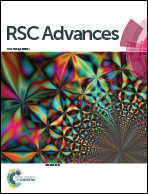DFT-based study on the mechanisms of the oxygen reduction reaction on Co(acetylacetonate)2 supported by N-doped graphene nanoribbon†
Abstract
Development of low-cost and highly efficient electrocatalysts for oxygen reduction reaction (ORR) is still a great challenge for the large-scale application of fuel cells and metal–air batteries. In this work, by means of density functional theory (DFT) computations, we have systemically explored the anchoring of Co(acac)2 (acac = acetylacetonate) on N-doped graphene nanoribbon and its potential as the ORR electrocatalyst. Our DFT computations revealed that N-doped graphene nanoribbon can be used as the anchoring material of the Co(acac)2 complex due to the formation of a Co–O4–N moiety, thus ensuring its high stability. Especially, an O2 molecule can be moderately activated on the surface of the anchored Co(acac)2 complex, and the subsequent ORR steps prefer to proceed though a more efficient 4e pathway with a small overpotential (0.67 V). Therefore, the hybridization of Co(acac)2 with N-doped graphene can give rise to outstanding catalytic performance for ORR in fuel cells.


 Please wait while we load your content...
Please wait while we load your content...